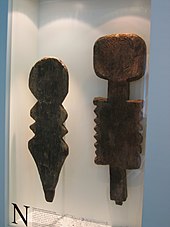State Museum of Nature and Man Oldenburg
The Landesmuseum Natur und Mensch Oldenburg in Oldenburg (Oldenburg) is a nationally important collection museum with the departments of archeology , natural history and ethnology . The focus is on the geology and moor archeology of north-west Germany. The Natural History Department also houses the interdisciplinary permanent exhibition Moor & Geest and Coast & Marsch . Special exhibitions complement the museum's program.
history
The Landesmuseum Natur und Mensch Oldenburg was opened in 1836 by Grand Duke Paul Friedrich August as the Natural History Museum Oldenburg. The first director of the museum was Lord Chamberlain Alexander von Rennenkampff , known in Easterburg as the builder of the "Villa Rennenkampff".
The foundation of the collection was laid by purchasing 9,800 preserved insects , 490 birds and 26 small native mammals . In 1835, on behalf of the Grand Duke, Baron von Rennenkampff bought this private collection for 3,000 Reichstaler in gold from the district physicist Dr. Otto Ernst Oppermann from Delmenhorst . Dr. Oppermann with a new approach, the taxidermy revolutionized and in 1835 a 350 page book written on this entitled "about art contemporary stuffing of animals, ...". Due to the personal commitment of the Grand Duke, the collection was steadily expanded, the focus was on the recording of the local fauna and a scientific local research, the focus of which was Oldenburg. In 1867 the ethnographic collection, the natural history cabinet and the antiquity collection from the Duke's castle were integrated into the museum. In 1880 a new building was necessary to house the increased collections. Since then, the museum has been at its current location. On the night of September 22nd to 23rd, 1943, the building was badly damaged in an air raid on Oldenburg .

The intense reflection on one's own past, which increasingly shaped the design of cultural institutions at the beginning of the 20th century, ensures that archeology is the focus of the museum's attention. The research of the cultural heritage and the communication of prehistory and early history to a wide audience became the central task.
With the political and economic changes of the early 20th century, the sponsorship and name of the museum also changed: first it became the State Natural History Museum, then in 1938 the State Museum for Natural History and Prehistory.
In 1971 the grounds of the museum were expanded to include the neighboring former building of the Oldenburg State Library , thus creating more space for permanent and special exhibitions.
Since 1995, the design of the permanent exhibition has followed the idea of presenting the integration of natural and cultural history and the development and work of humans and animals in it in an interdisciplinary manner. Central themes are moor, geest, coast and marshland, the typical landscapes of the north-west German coastal region. As a link between the regions which serves Hunte , which flows through it. In a large aquarium , aquatic animals, insects and plants, whose habitat is the hunte, are presented.
literature
- Etta Bengen: The Grand Ducal Natural History Museum . In: Jörgen Welp (Red.): Dedicated to the well-being of Oldenburg: Aspects of the cultural and social work of the House of Oldenburg, 1773–1918 (= publications of the Oldenburg landscape . Vol. 9). Published by the Oldenburg landscape, Isensee, Oldenburg 2004, ISBN 3-89995-142-5 , p. 159 ff.
- Mamoun Fansa (ed.): About the art of imparting knowledge. 175 years of the Landesmuseum Natur und Mensch. History and present. Wienand Verlag, Cologne 2011, ISBN 978-3-86832-079-4
- The ethnological collection of the Landesmuseum Natur und Mensch Oldenburg . In: Gundolf Krüger, Ulrich Menter, Jutta Steffen-Schrade (eds.): TABU ?! Hidden Powers - Secret Knowledge. Imhof Verlag, Petersberg 2012, pages 105-107 and numerous images from the museum's holdings. ISBN 978-3-86568-864-4
Web links
- Literature by and about the Landesmuseum Natur und Mensch Oldenburg in the catalog of the German National Library
- www.naturundmensch.de
- From the magazines of the Landesarchiv - purchase contract for the private collection Dr. Oppermanns
- Dr. Oppermann - "about the artful stuffing of animals"
Individual evidence
- ↑ Lower Saxony State Archives: Purchase Agreement from 1835 , (State Archives Oldenburg, Rep. 751, Akz. 2010/054, No. 3)
- ↑ Jörg Deuter: Oldenburg - a north German townscape , p. 215. Oldenburg 1988.
Coordinates: 53 ° 8 ′ 1.4 ″ N , 8 ° 13 ′ 10.2 ″ E

